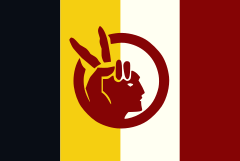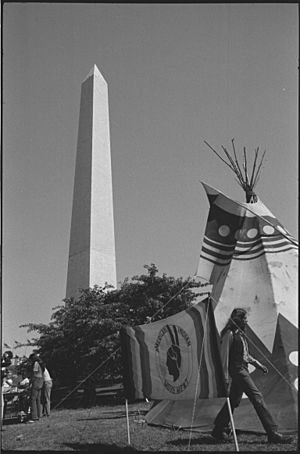American Indian Movement facts for kids
Quick facts for kids
American Indian Movement
|
|
|---|---|
 |
|
| Abbreviation | AIM |
| Leader | Dennis Banks Clyde Bellecourt Vernon Bellecourt Russell Means |
| Founded | July 1968 |
| Ideology | Indigenism American Indian civil rights Anti-racism Anti-imperialism Pan-Indianism |
| Political position | Left-wing |
| Colors | Black Gold White Maroon |
The American Indian Movement (AIM) is a civil rights group for American Indians. It was started in Minneapolis, Minnesota, in July 1968. At first, AIM focused on helping American Indians living in cities. They fought against poverty, unfair treatment, and police mistreatment.
Soon, AIM began working on issues that affected all Indigenous tribes. These problems were often caused by settler colonialism, where outsiders settled on Native lands. AIM fought for treaty rights, better job opportunities, and the teaching of American Indian history in schools. They also worked to protect and celebrate Indigenous cultures.
The founders of AIM were American Indian men who had similar life experiences. Many had been sent to boarding schools, served in the military, or moved from reservations to cities. This move was part of a government plan called the Indian Relocation Act of 1956. The act encouraged Native Americans to leave their reservations for cities to find work.
This policy, along with others, led to about 70% of American Indians moving to cities. Life in the city was often difficult. But it also brought many different Native people together. They began to organize, and from these efforts, the American Indian Movement was born.
Contents
What Was AIM's Mission?
The American Indian Movement wanted to improve the lives of Native Americans. They led protests to protect the rights and interests of Indigenous people. They also inspired a renewal of Native cultures and traditions.
AIM monitored police actions to prevent mistreatment. They also set up job programs in cities and on reservations. Over the years, AIM has also worked with Indigenous groups in other countries.
Early Protests and Events
AIM became known for its bold protests. They knew how to get the media's attention to share their message with the public.
- Occupation of Alcatraz: From 1969 to 1971, AIM joined other Native groups in occupying Alcatraz Island. The island had an abandoned federal prison. The protesters claimed the land under an old treaty.
- Trail of Broken Treaties: In 1972, AIM organized a march to Washington, D.C., called the Trail of Broken Treaties. They brought a list of 20 demands to the government. These demands were meant to fix the relationship between the U.S. and Native Nations.
- Wounded Knee Occupation: In 1973, AIM led an occupation of Wounded Knee on the Pine Ridge Indian Reservation. This event lasted 71 days and drew worldwide attention to the problems Native Americans faced.
Major Events in AIM's History
AIM organized many events to fight for Native American rights. These actions helped bring attention to their cause and led to important changes.
The Longest Walk of 1978

In 1978, AIM led a spiritual walk across the country called "The Longest Walk." The walk was a protest against new laws that threatened tribal sovereignty (the right of tribes to govern themselves) and treaty rights.
Thousands of people from many different tribes walked 3,200 miles to Washington, D.C. They wanted to educate the public about the government's broken promises. Famous supporters like boxer Muhammad Ali and actor Marlon Brando helped bring attention to the walk.
When the walkers arrived in Washington, D.C., they held ceremonies and rallies. President Jimmy Carter did not meet with them, but Congress decided not to pass the harmful bills. Instead, they passed the American Indian Religious Freedom Act. This law protected the right of Native Americans to practice their traditional religions.
The Longest Walk 2 of 2008
Thirty years later, AIM organized another walk called "The Longest Walk 2." This walk was even longer, covering 8,200 miles. It brought together people from over 100 American Indian nations.
The walk focused on new issues, like protecting sacred sites and the environment. The walkers also demanded action on global warming. They delivered a list of demands to the government, calling for positive changes for Native communities.
Protesting Team Mascots
AIM has long protested against sports teams that use Native American figures as mascots. They argue that using names like the Washington Redskins or images like the Cleveland Indians' Chief Wahoo is disrespectful.
AIM organized protests at major sporting events like the World Series and the Super Bowl. Their efforts helped raise awareness about the issue. As a result, some teams, like the ones in Cleveland and Washington, have changed their names.
Working for Justice on Pine Ridge Reservation
Much of AIM's early work focused on the Pine Ridge Indian Reservation in South Dakota. They were invited by local elders to help fight for justice and deal with political problems on the reservation.
The Wounded Knee Incident of 1973
In 1973, AIM activists and Oglala Lakota members occupied the town of Wounded Knee. The site was chosen because it was where the U.S. Army had massacred Lakota people in 1890. The occupation was a protest against a corrupt tribal government and the U.S. government's failure to honor its treaties.
The standoff with federal agents lasted for 71 days. The event received major media coverage around the world. Actor Marlon Brando even refused to accept his Oscar for The Godfather. He sent Native American activist Sacheen Littlefeather to speak on his behalf about the poor treatment of Native Americans and the events at Wounded Knee.
The occupation ended after two Native activists were killed in shootouts. While the protest was a difficult and violent time, it succeeded in showing the world the struggles of American Indians.
Violence and FBI Involvement
The years after Wounded Knee were a time of great conflict on the Pine Ridge reservation. There was a lot of violence, and many of AIM's opponents died. This period is sometimes called the "Pine Ridge Reign of Terror."
In 1975, a shootout occurred between AIM members and two FBI agents, who were both killed. An AIM member was also killed. This event led to a famous legal case involving AIM member Leonard Peltier. He was convicted of the agents' deaths, but many people believe he did not receive a fair trial. His case is still a major focus for AIM and human rights groups today.
The FBI also used informants to gather information on AIM. This created a lot of distrust within the movement. The case of Anna Mae Aquash, a high-ranking woman in AIM who was killed in 1975, highlighted these deep divisions and fears.
AIM's Lasting Impact
AIM has made a lasting difference for Native American communities. The movement has split into different groups over the years, but many chapters continue to work for Indigenous rights.
Creating New Institutions
AIM founded many important organizations to serve Native communities. These include:
- Heart of The Earth School: A school in Minneapolis that provided education based on Native culture.
- Little Earth Housing: The first American Indian-run housing project in the country.
- International Indian Treaty Council: An organization that represents Indigenous peoples at the United Nations.
- Job Training Programs: The American Indian Opportunities and Industrialization Center has trained thousands of people for jobs.
Fighting for Indigenous Rights Worldwide
In 1974, AIM created the International Indian Treaty Council (IITC). The IITC works to protect the rights of Indigenous peoples all over the world. In 1977, it became an official organization at the United Nations.
Thanks in part to the work of the IITC and other groups, the UN adopted the Declaration on the Rights of Indigenous Peoples in 2007. This declaration recognizes the rights of Indigenous peoples to their land, culture, and self-determination.
See also
 In Spanish: American Indian Movement para niños
In Spanish: American Indian Movement para niños
- Black Lives Matter
- Black Panther Party
- Brown Berets
- Civil rights movement
- History of civil rights in the United States
- Human rights in the United States
- Native American civil rights
- Red Power movement
- Young Lords Party


